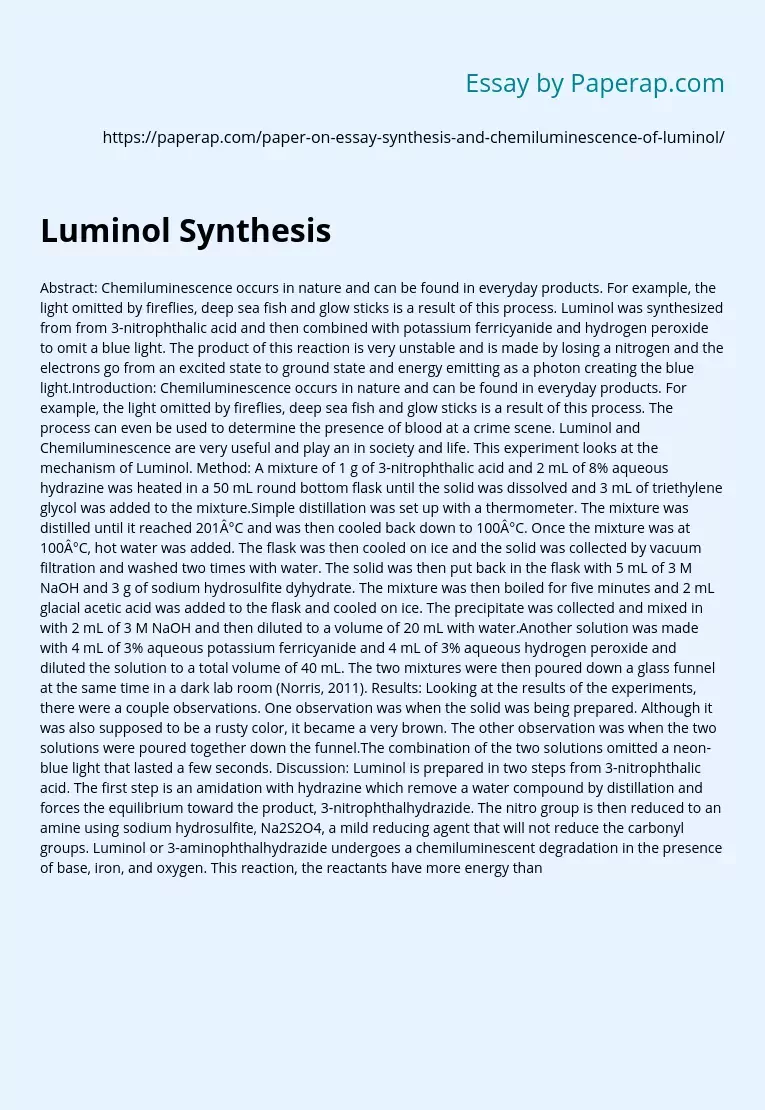Luminol Synthesis
Abstract: Chemiluminescence occurs in nature and can be found in everyday products. For example, the light omitted by fireflies, deep sea fish and glow sticks is a result of this process. Luminol was synthesized from from 3-nitrophthalic acid and then combined with potassium ferricyanide and hydrogen peroxide to omit a blue light. The product of this reaction is very unstable and is made by losing a nitrogen and the electrons go from an excited state to ground state and energy emitting as a photon creating the blue light.
Introduction: Chemiluminescence occurs in nature and can be found in everyday products. For example, the light omitted by fireflies, deep sea fish and glow sticks is a result of this process. The process can even be used to determine the presence of blood at a crime scene. Luminol and Chemiluminescence are very useful and play an in society and life. This experiment looks at the mechanism of Luminol. Method: A mixture of 1 g of 3-nitrophthalic acid and 2 mL of 8% aqueous hydrazine was heated in a 50 mL round bottom flask until the solid was dissolved and 3 mL of triethylene glycol was added to the mixture.
Simple distillation was set up with a thermometer. The mixture was distilled until it reached 201°C and was then cooled back down to 100°C. Once the mixture was at 100°C, hot water was added. The flask was then cooled on ice and the solid was collected by vacuum filtration and washed two times with water. The solid was then put back in the flask with 5 mL of 3 M NaOH and 3 g of sodium hydrosulfite dyhydrate.
The mixture was then boiled for five minutes and 2 mL glacial acetic acid was added to the flask and cooled on ice. The precipitate was collected and mixed in with 2 mL of 3 M NaOH and then diluted to a volume of 20 mL with water.Another solution was made with 4 mL of 3% aqueous potassium ferricyanide and 4 mL of 3% aqueous hydrogen peroxide and diluted the solution to a total volume of 40 mL. The two mixtures were then poured down a glass funnel at the same time in a dark lab room (Norris, 2011). Results: Looking at the results of the experiments, there were a couple observations. One observation was when the solid was being prepared. Although it was also supposed to be a rusty color, it became a very brown. The other observation was when the two solutions were poured together down the funnel.The combination of the two solutions omitted a neon-blue light that lasted a few seconds. Discussion: Luminol is prepared in two steps from 3-nitrophthalic acid. The first step is an amidation with hydrazine which remove a water compound by distillation and forces the equilibrium toward the product, 3-nitrophthalhydrazide. The nitro group is then reduced to an amine using sodium hydrosulfite, Na2S2O4, a mild reducing agent that will not reduce the carbonyl groups. Luminol or 3-aminophthalhydrazide undergoes a chemiluminescent degradation in the presence of base, iron, and oxygen. This reaction, the reactants have more energy than the product.In order to get rid of the excess energy, it is given off in the form of light reflected by photons. This reaction has been used to detect residual blood stains at crime scenes. This reaction also happens in fireflies and glow sticks. In the reaction done in lab, the luminol reacted with the iron atom in the potassium ferricyanide. To create the luminescent effect, the luminol had to be activated with an oxidant. The oxidant in this case was the hydrogen peroxide. The metal salt potassium ferricyanide acts as a catalyst for the reaction, breaking down the hydrogen peroxide to water and oxygen.When luminol reacts with the hydroxide salt, solution #2, a dianion is formed. The oxygen from the hydrogen peroxide then reacts with the luminol dianion. The product of this reaction is very unstable and is made by losing a nitrogen and the electrons go from an excited state to ground state and energy emitting as a photon. This process causes the blue light to show. This reaction works with any metal like copper or iron. References: Norris, 2011. Synthsis and Chemiluminescence of Luminol, pp. 1-6. Frostburg State University.
Luminol Synthesis. (2019, Dec 05). Retrieved from https://paperap.com/paper-on-essay-synthesis-and-chemiluminescence-of-luminol/

